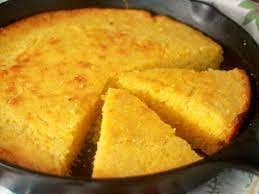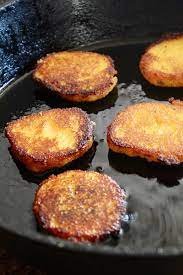Cornbread - A Pillar of Black Cuisine
Search terms: cornbread, cornbread history, cornbread origin, cornbread church, corn pone, hot water cornbread, cornbread recipe, cornbread slavery
Skillet cornbread
Cornbread is simple. A crumbly dish made of cornmeal, eggs, and oil, it is a pinnacle of Southern American cuisine, specifically Black American cuisine.
Culinary historian and professor, Jessica B. Harris, discusses the origins of corn pone also known as hot water cornbread or hoe cakes. These dishes are variations of cornbread usually made with simply cornmeal, light oil, and hot water, cooked in a skillet, “You don't have to be a scholar, you don't have to have a high school degree, a college degree or even a grade school degree to know dinner, but if somebody comes to you and say, "What you got on your plate for dinner?" and you say, "I got some chitterlings and some black-eyed peas and rice and some collard greens with some hot sauce, and maybe some cornbread or some corn pone," and that person can get back to you and say, "well you know your history's on that plate," 'cause the corn pone comes from the lake with the Indians [Native Americans] 'cause the word pone is basically a Native American word, and the corn was part of the three sisters: corn, squash and beans, because they grew in symbiosis. The corn provided the stalk, the beans grew around it and the squash could shade things.”
Hot water cornbread
Civil rights activist and pastor Reverend Samuel “Billy” Kyles gives context to how Black people adapted hot water cornbread, “our ancestors found ways to cope, coping mechanism, they didn't know they were coping mechanisms, but the innards of the hog that was thrown away, they took it and made it delicacies out of them, you know. Couldn't make a whole cornbread, so they short cutted with what they had and made hot water cornbread”
This ingenuity would continue on in the cuisine of enslaved people. Civic leader Paul Jones discusses his parents’ childhood in Alabama picking cotton and what they would eat after a long day, “You'd you have a nice, big, thick cake of cornbread made from grinding the meal that they'd gotten from the corn that they picked and put in shelter, and taken to the mill where they would take it--if you took a bushel of corn in, they'd take a peck of it and keep for themselves and grind the rest up for meal for you. Or if you're feeding your hogs, they'd grind it up in a different fashion for chops from the hogs. And then you'd go in and get a pot of butterbeans and cornbread and offer 'em sweetened water, which was nothing but a glass of water with sugar, no ice, no flavor, but it was a meal.”
Person eating corn
Cornbread remained a staple in Black households post slavery as well. Dr. Terry Mason who was born in 1951 describes the foods he ate growing up, “both my parents [Clarice Fortune Johnson and Mason's stepfather, Thomas Johnson] were from the South, 'cause you know, that was the upward migration during that time. But it wasn't just pork. It wasn't just ribs. It wasn't just meat. I mean, the staple of what we ate was still beans. It was beans. It was rice. It was cornbread. It was--you know, that's, that's what really held us together.”
Sallie Ann Robinson, a chef and culinary historian, tells how she grew up with cornbread, “I remember them having pans of cornbread every day. Cornbread was a big part of our diet. Rice, we ate it every day.”
Growing up in Texas, Otis Clayborn Williams of The Temptations has fond memories involving cornbread, “I remember when coveralls--you know, and running up and down the gravel roads of Texas barefooted. You know, running around with hot water cornbread in one hand and, you know, playing hide and go seek.”
For folk singer Ella Jenkins, cornbread and buttermilk went hand in hand, “I love cornbread, and see when I was growing up we had cornbread--we had--my mother cooked real well. We drank buttermilk. I never hear people talk about buttermilk anymore, but we--and sometimes I put a glass of buttermilk and then I put some cornbread in it and stir it up, it would, tasted very good”
Cornbread in buttermilk
Television producer Valerie Norman-Gammon also experienced a memorable cornbread combination, “My great grandmother, my grandmother [Verna Clair] would make hot water cornbread and collard greens and sit and take the tomatoes and the green and the vinegar and put it on there and eat it. And my grandmother used to--my great grandmother [Mary Lee Armstrong] would reach down and eat it with her hands, I remember all of that; that was so wonderful.”
For Jonathan Green, painter of Black Southern life, cornbread conjures rich memories of cooking with his grandmother, “where I live I create my--I create the smells that remind me of childhood, like baking yams in the oven, putting on a pot of beans or cooking some rice and making cornbread. And when I do that, it immediately takes me back to my childhood, listening to music, listening to Etta James, listening to Temptations, Four Tops, listening to B.B. King, any of those type people,”
Jeff Henderson, chef and nonprofit CEO, was formerly incarcerated on drug charges. After he left prison he had a chef mentor Friendly Womack Jr. (eldest brother of Bobby Womack). Womack taught him many technical skills when it came to cooking, “He taught me everything, you know. He taught me how to work the equipment and, you know, the steamers, the kettles and the ovens; and how sometimes the ovens cooked at a certain heat temperatures, certain areas of the oven; had to turn and rotate the cornbread and different things like that”
Cornbread is also a dish that has numerous connections to the church. Vernon Jones, the youngest county government administrator of DeKalb County, Georgia describes a funny conversation that happened when a preacher visited his aunt’s house for dinner. Another man, widower and veteran Ted Quick was at the dinner, “The preacher was there, he was there, and they were talking. They were about to eat. And they were talking about cornbread. And the preacher was talking about how much he loves cornbread, and old man, Mr. Ted Quick, was saying that he loved it, but he was talking about how much he ate when he was a kid. He said that I'd eaten so much cornbread, you could have shucked my shit. And, and I--my aunt got so furious for him cursing in front of the, the preacher like that. And she cleaned that house; she cleared everybody out. And it was, it was because it was so--and I'm saying all that to say it was so much respect for the minister, and you'd better not say anything out of line. And for him to just--he was just saying, you know, two men sitting there, they were just talking.
Church potluck
Some make their cornbread savory while others make it sweet, almost like a cake. Curator, librarian, and collector Mayme Clayton offers a humorous story about sweet cornbread, “Now they would, they would have socials at the, at the church in the basement and I remember one time they had a dinner in the basement and everybody would bring food, like potluck. And so my father was eating, eating his food and, and he say, hey--he was talking to my mother [Mary Knight Agnew], he said, "Mary, this is some good cornbread." She said, "Shut up, that's Mrs. Johnson's [ph.] cake." (Laughter) He called it cornbread (laughter). She, she had to hunch him and tell him to shut up (laughter).”
Cornbread is quite versatile: it can be eaten with buttermilk like Ella Jenkins did or with pickled tomatoes like Valerie Norman-Gammon’s great grandmother did. It is also accessible: it uses relatively cheap and simple ingredients and does not need time to rise or proof like yeast-filled baked goods. Because of these qualities and rich history and memories it carries with it, cornbread has remained a pillar of Black Southern cuisine.
Student Ambassador Update
I spoke to one of my former English professors about The Black History Month Contest this week and he sent the information out to his students. He is also excited about the archive so I am setting up a longer meeting to show him how he can incorporate the archive into his classes We have 8 students registered for the contest and one has submitted their poem so far. I created a demo video of the archive to help students with their research for the poetry contest.
References
Bridenstine, Sarah. “What Is Hot Water Cornbread? (and How Do You Make It?).” Baking Kneads, LLC, 30 Nov. 2022, https://www.bakingkneads.com/what-is-hot-water-cornbread/.
Kaminsky Last Modified Date: January 09, A. “What Is Cornbread?” Delighted Cooking, 9 Jan. 2023, https://www.delightedcooking.com/what-is-cornbread.htm.
Jessica B. Harris (The HistoryMakers A2004.133), interviewed by Larry Crowe, August 18, 2004, The HistoryMakers Digital Archive. Session 1, tape 6, story 8, Jessica B. Harris reflects upon the history and cultural connections discerned by studying food
Reverend Samuel Billy Kyles (The HistoryMakers A2003.029), interviewed by Larry Crowe, February 13, 2003, The HistoryMakers Digital Archive. Session 1, tape 6, story 4, Reverend Samuel "Billy" Kyles calls for more frequent discussions about the impact of slavery, pt. 1
Paul Jones (The HistoryMakers A2003.195), interviewed by Jodi Merriday, August 16, 2003, The HistoryMakers Digital Archive. Session 1, tape 2, story 2, Paul Jones talks about how his parents met and African American cooking and nutrition in the late nineteenth and early twentieth century
Dr. Terry Mason (The HistoryMakers A2012.049), interviewed by Larry Crowe, May 2, 2018, The HistoryMakers Digital Archive. Session 2, tape 6, story 3, Dr. Terry Mason talks about changes in dietary norms amongst African Americans
Sallie Ann Robinson (The HistoryMakers A2017.045), interviewed by Denise Gines, February 9, 2017, The HistoryMakers Digital Archive. Session 1, tape 5, story 6, Sallie Ann Robinson remembers recipes from her childhood
Otis Clayborn Williams (The HistoryMakers A2008.068), interviewed by Jacques Lesure, April 1, 2008, The HistoryMakers Digital Archive. Session 1, tape 1, story 6, Otis Clayborn Williams describes his earliest childhood memory
Ella Jenkins (The HistoryMakers A2002.133), interviewed by Larry Crowe, August 5, 2002, The HistoryMakers Digital Archive. Session 1, tape 2, story 5, Ella Jenkins discusses African American and Southern dialects and culture
Valerie Norman-Gammon (The HistoryMakers A2012.233), interviewed by Lynn Norment, August 22, 2012, The HistoryMakers Digital Archive. Session 1, tape 1, story 7, Valerie Norman-Gammon describes the foods that her grandmother made in Memphis, Tennessee
Jonathan Green (The HistoryMakers A2002.055), interviewed by Julieanna L. Richardson, April 16, 2002, The HistoryMakers Digital Archive. Session 1, tape 1, story 10, Jonathan Green relates details of his childhood in.Gardens Corner, South Carolina
Jeff Henderson (The HistoryMakers A2007.128), interviewed by Paul Brock, April 7, 2007, The HistoryMakers Digital Archive. Session 1, tape 4, story 4, Jeff Henderson remembers the mentorship of Friendly Womack, Jr.
Vernon Jones (The HistoryMakers A2003.189), interviewed by Larry Crowe, August 14, 2003, The HistoryMakers Digital Archive. Session 1, tape 2, story 2, Vernon Jones talks about the role of the church in the rural southern community of his childhood
Mayme Clayton (The HistoryMakers A2004.196), interviewed by Larry Crowe, October 7, 2004, The HistoryMakers Digital Archive. Session 1, tape 2, story 4, Mayme Clayton recalls church activities at New Hope Baptist Church in Van Buren, Arkansas





